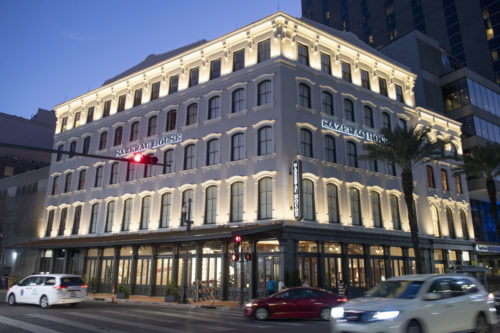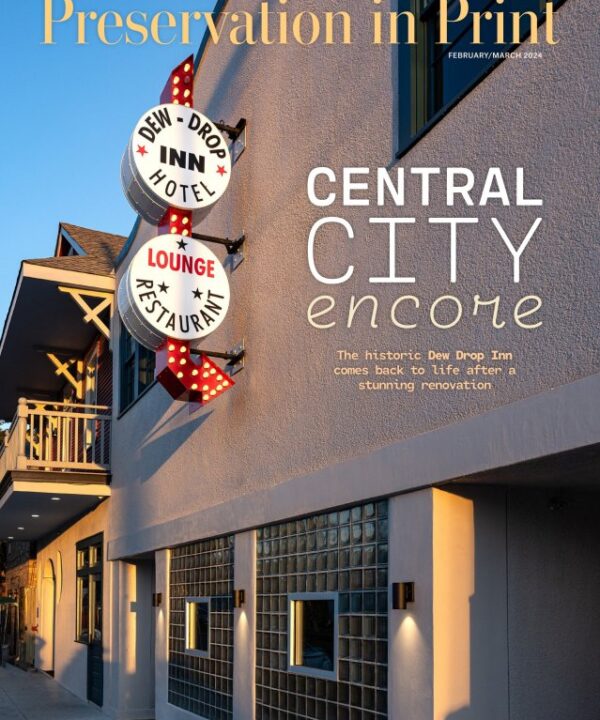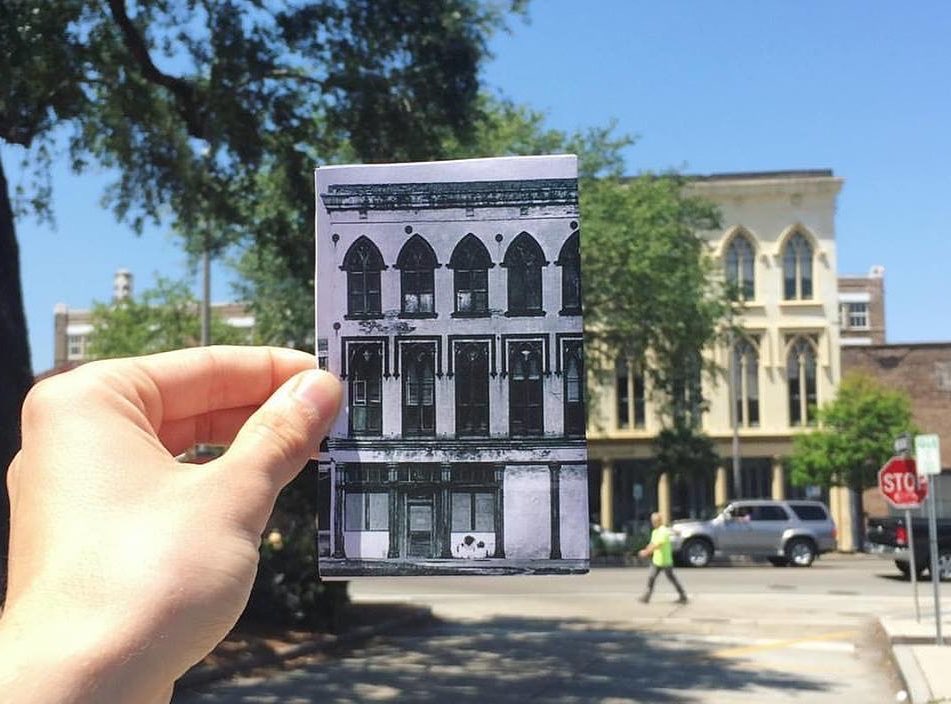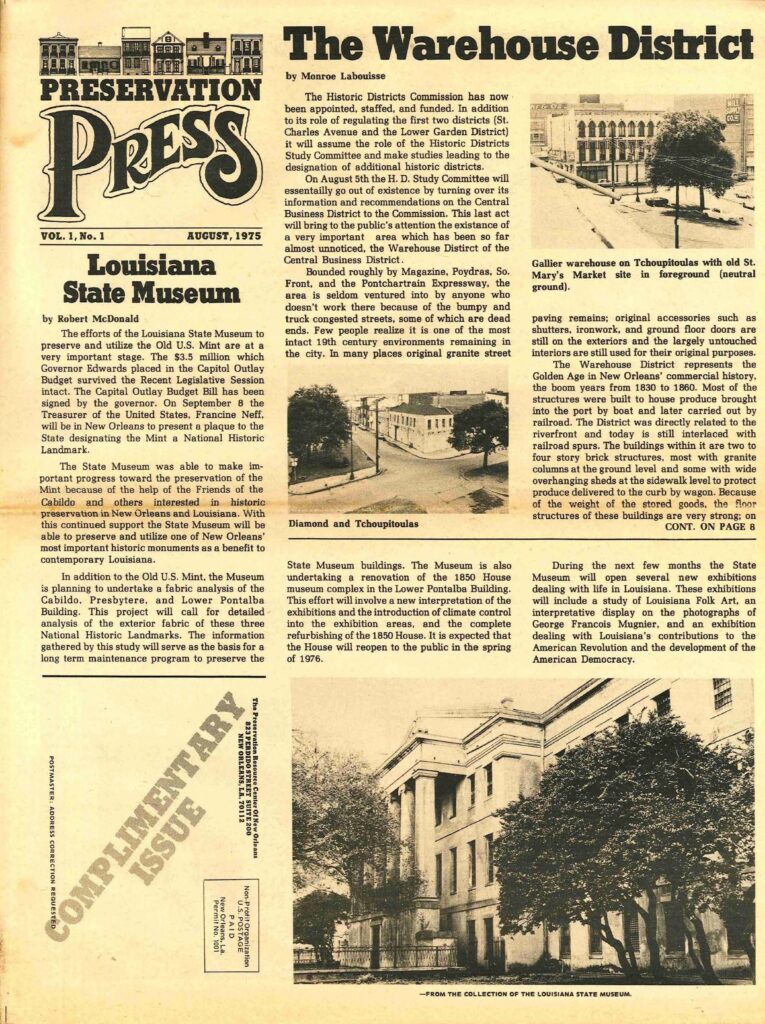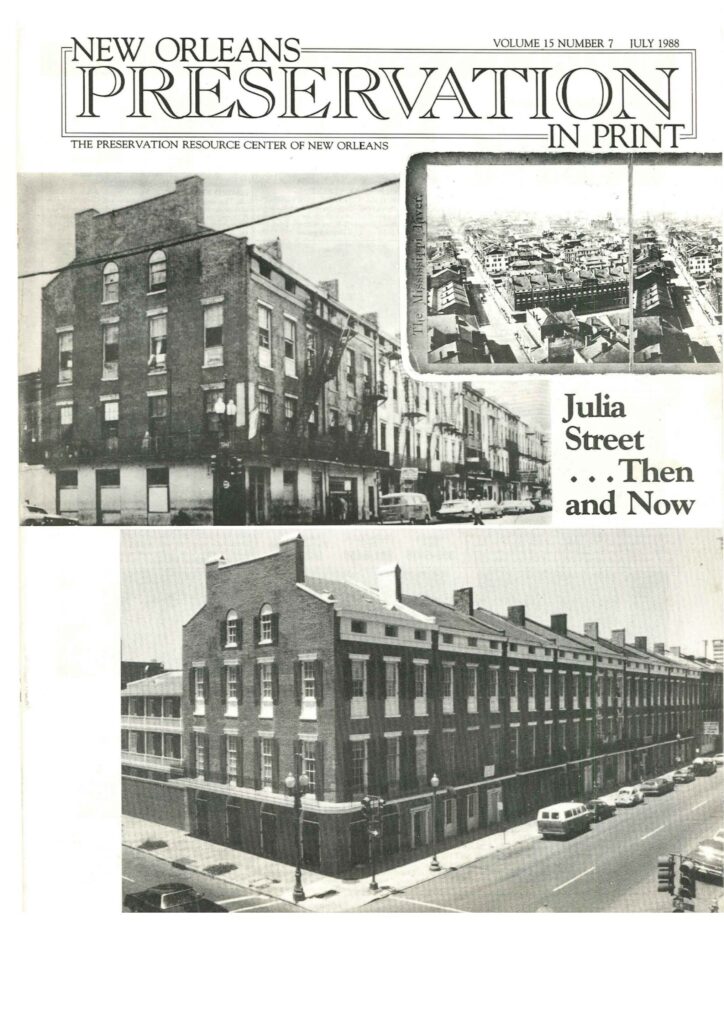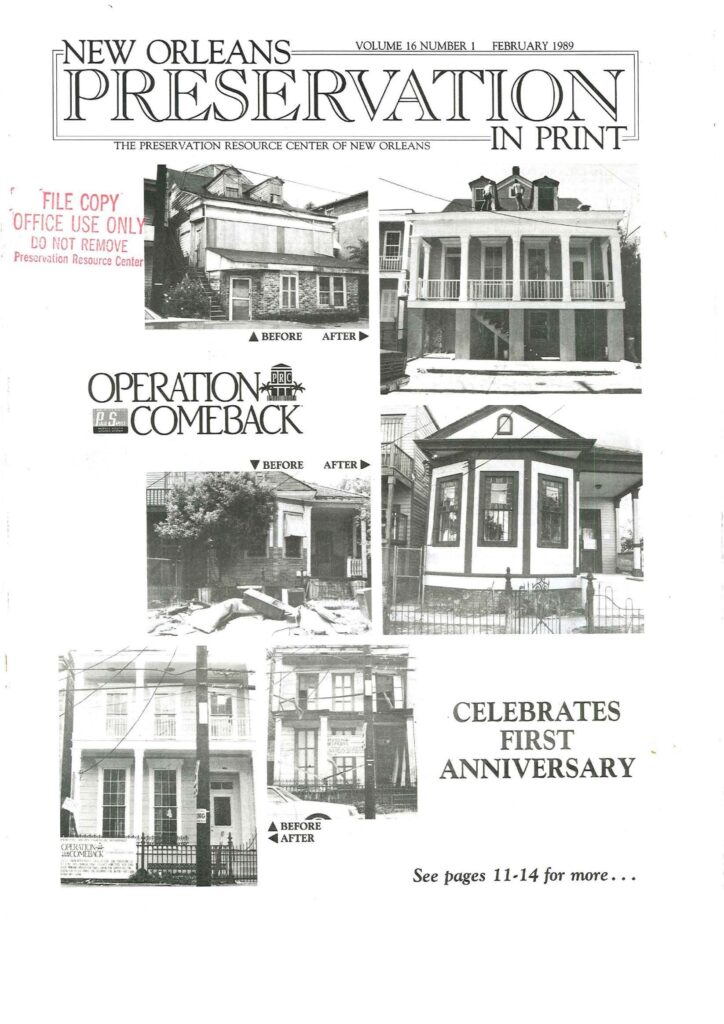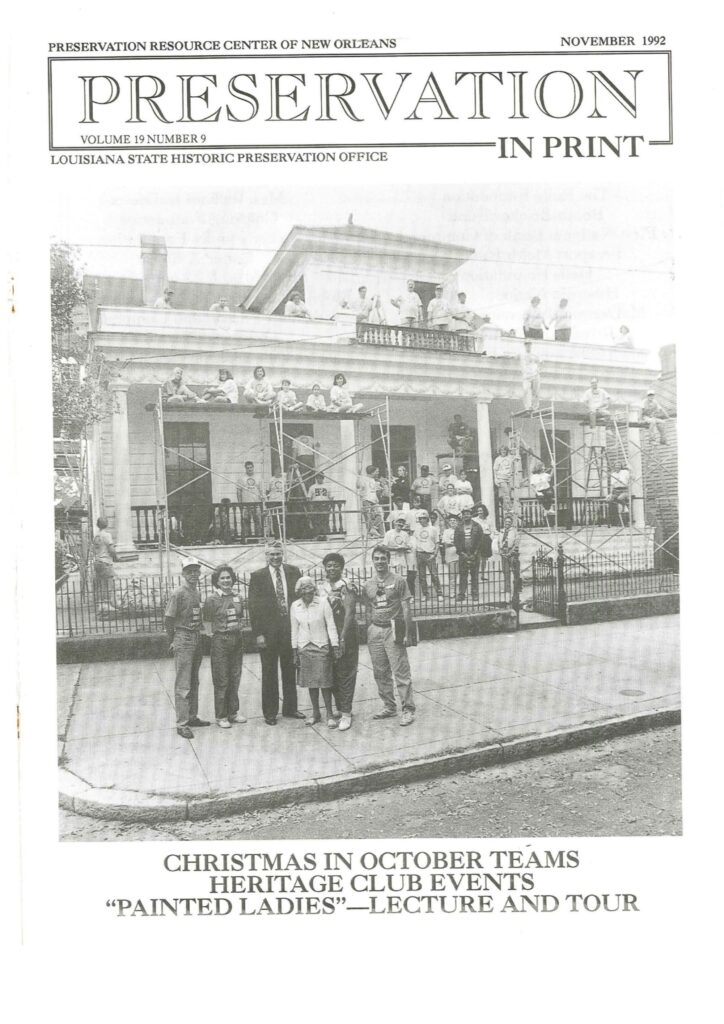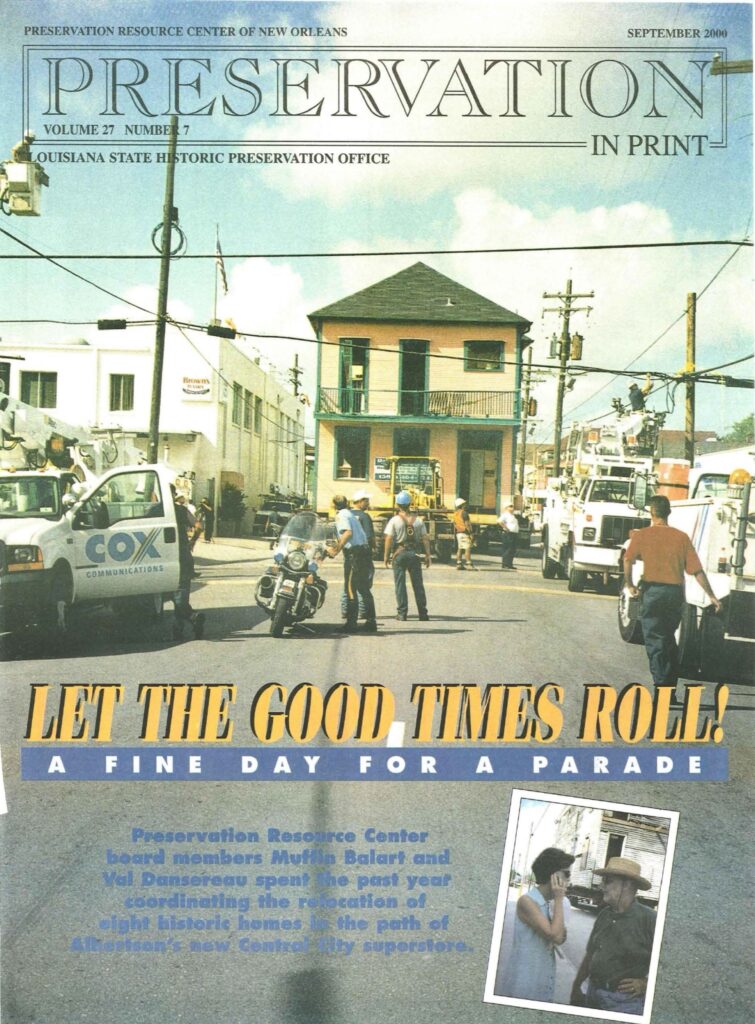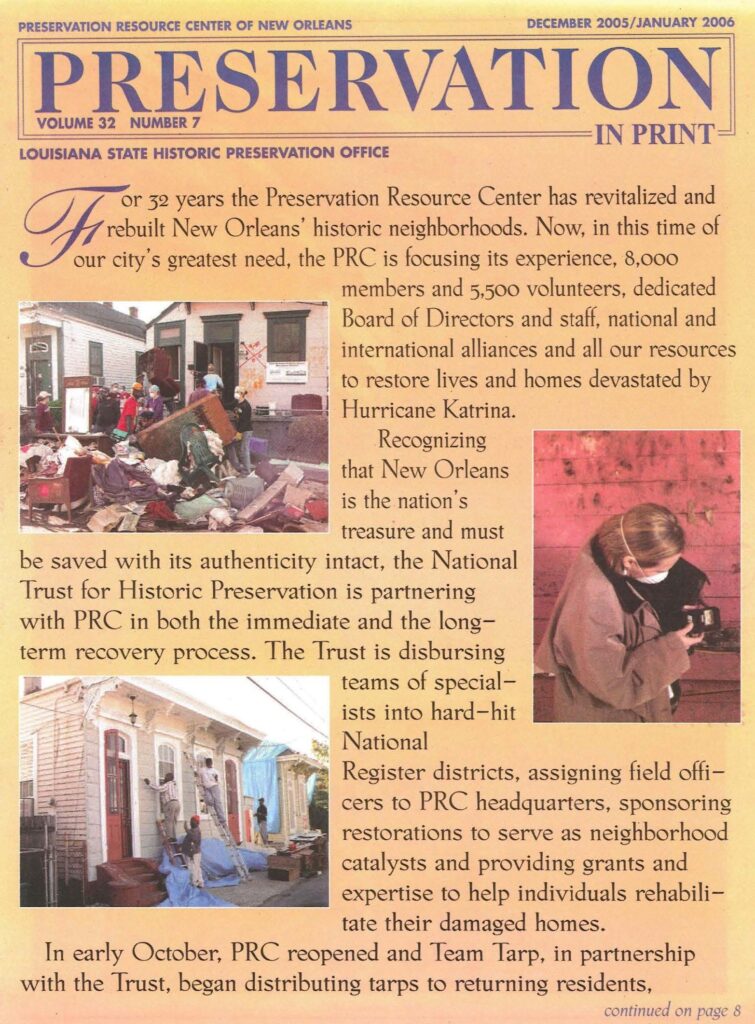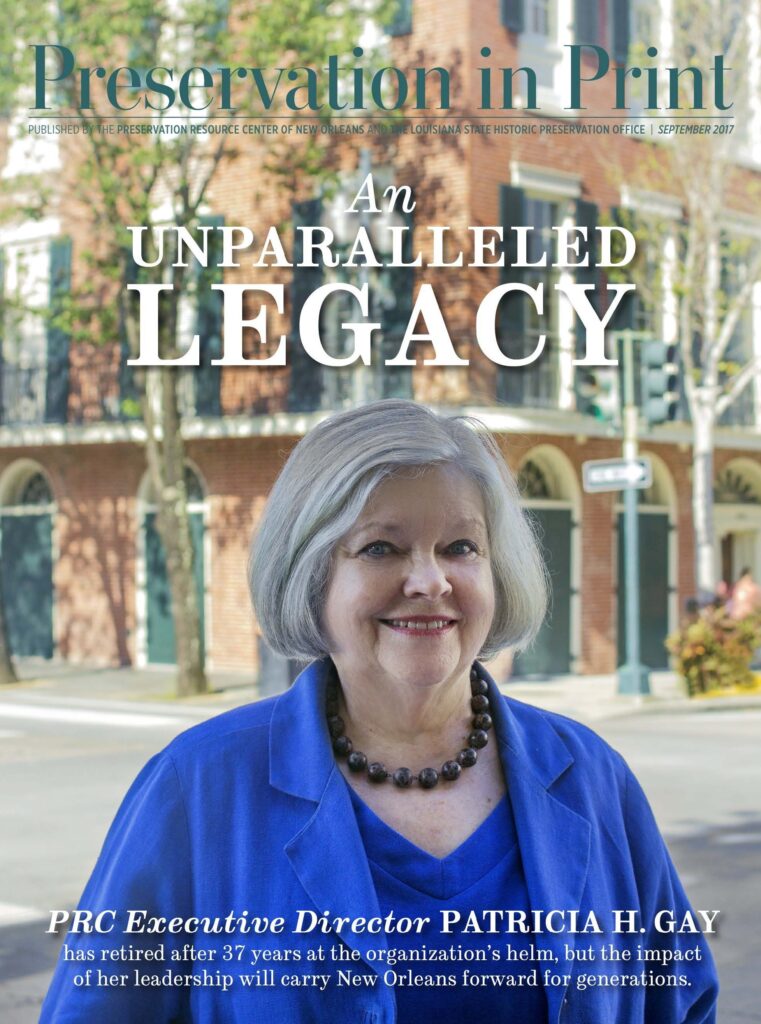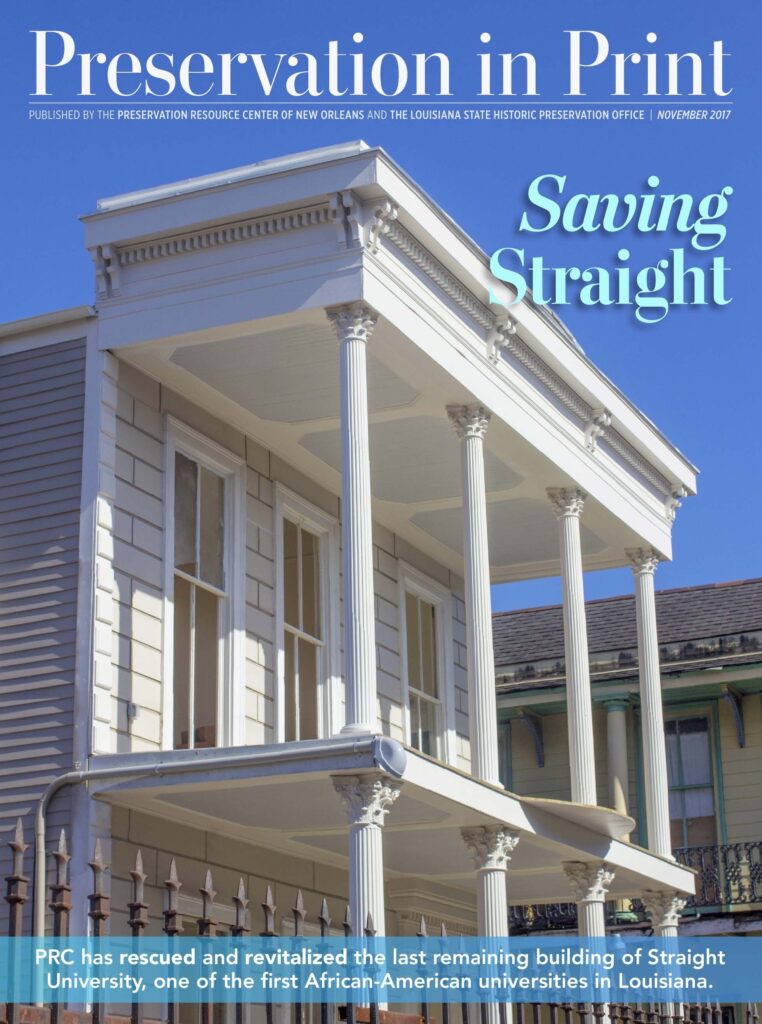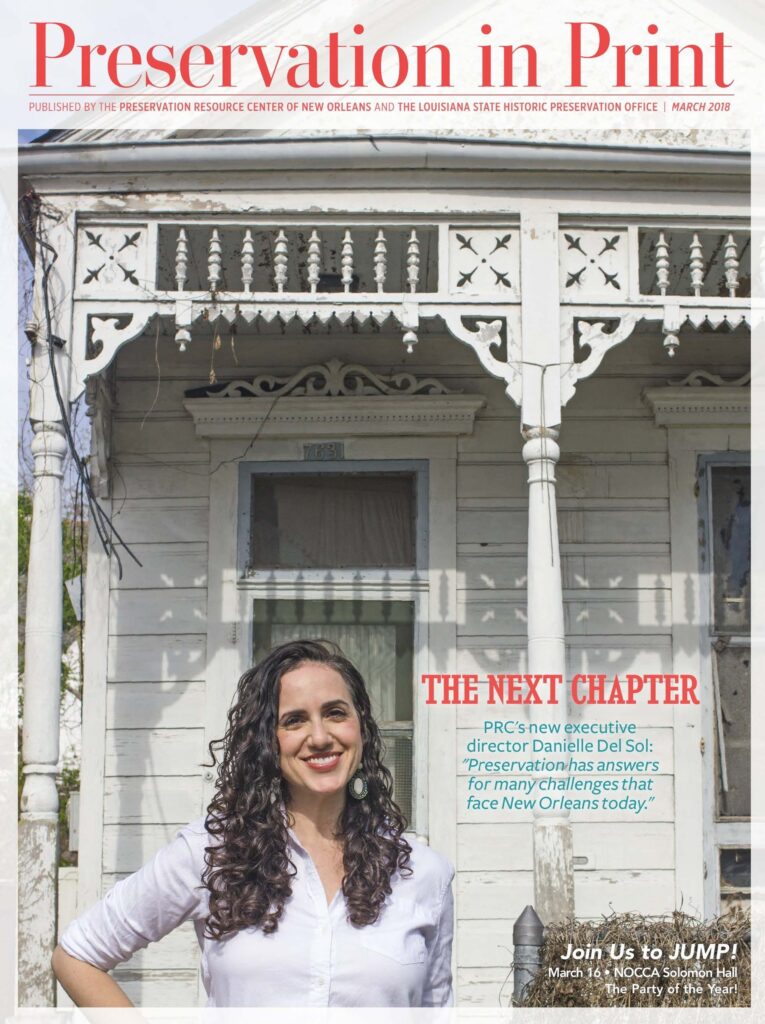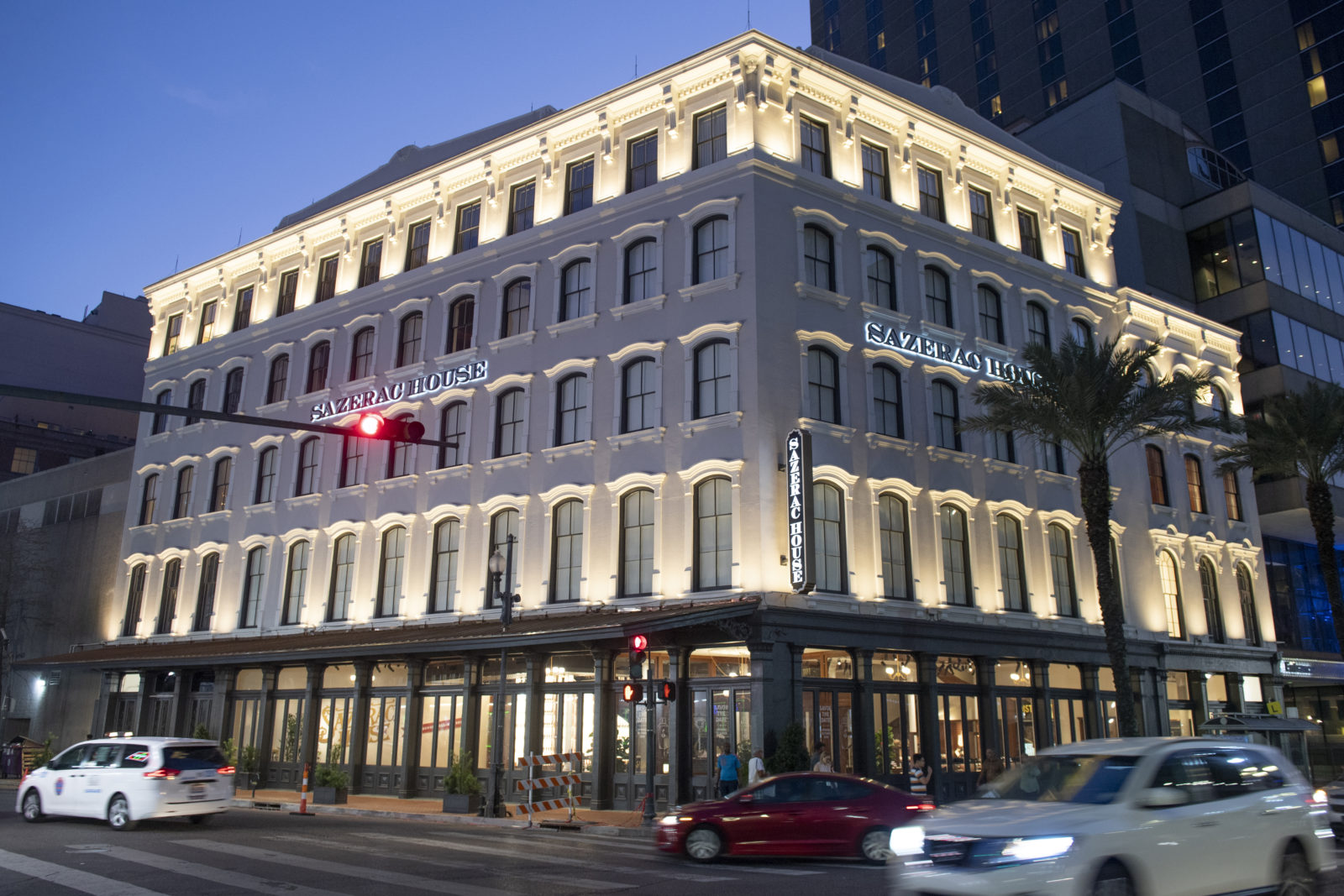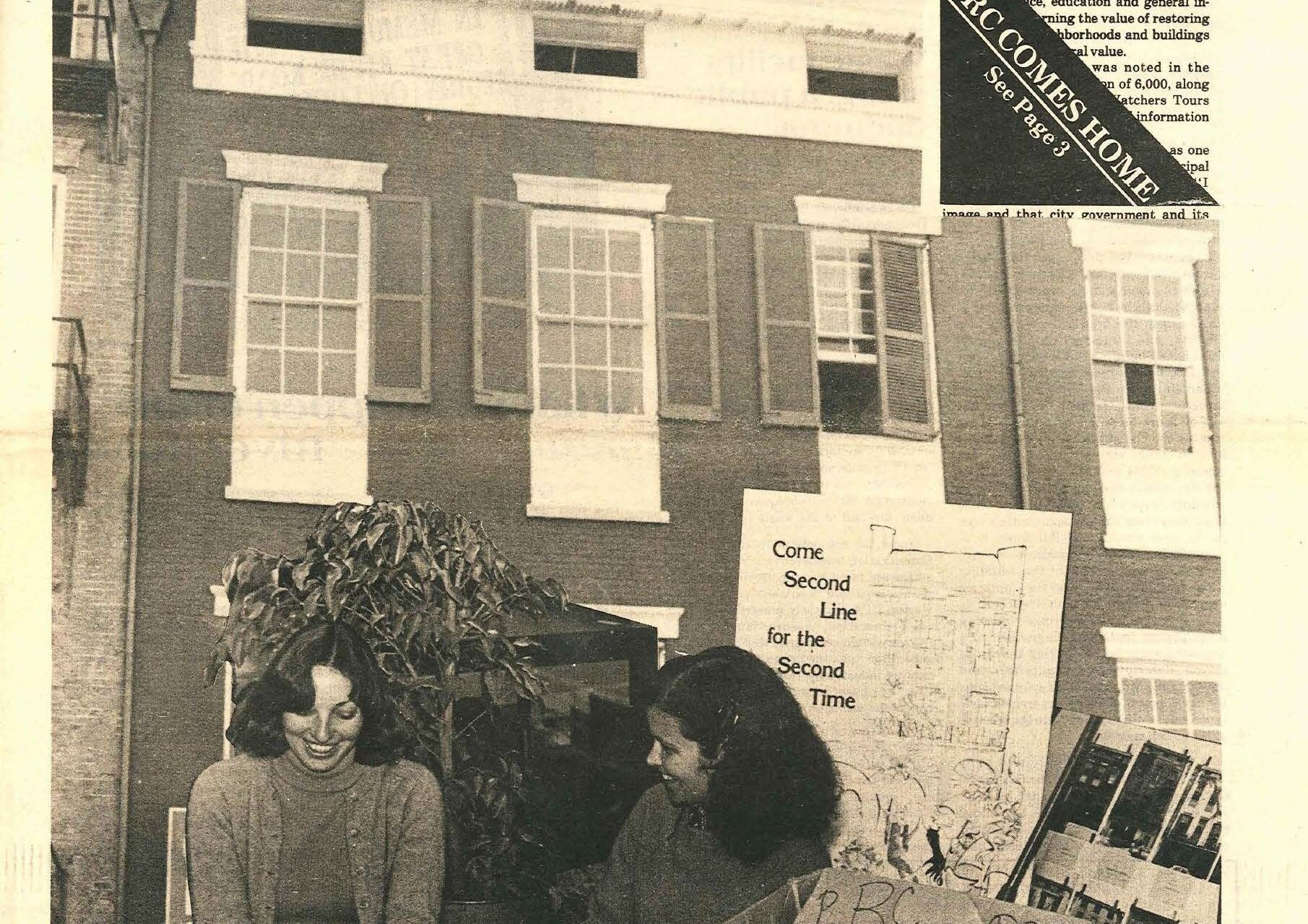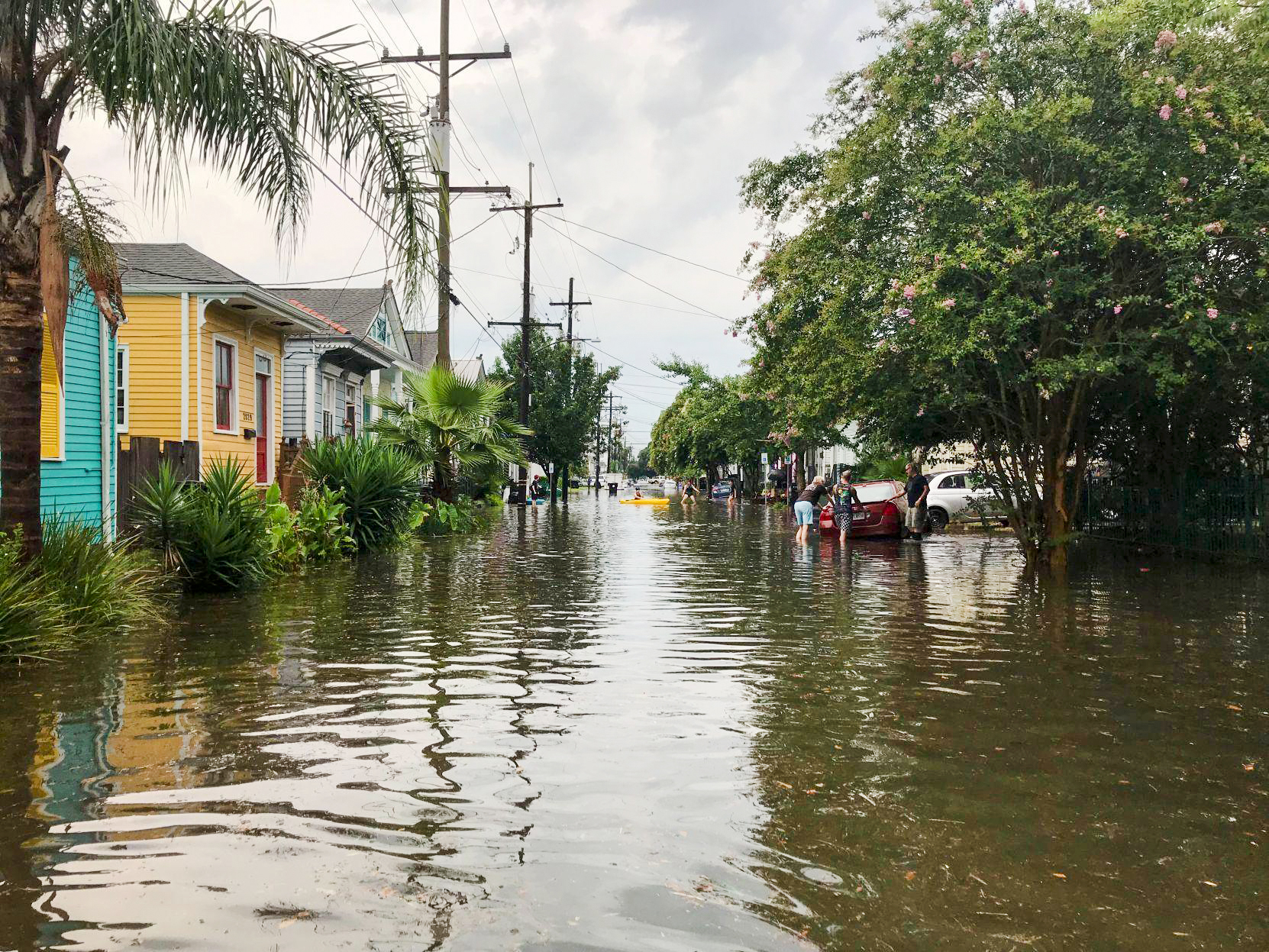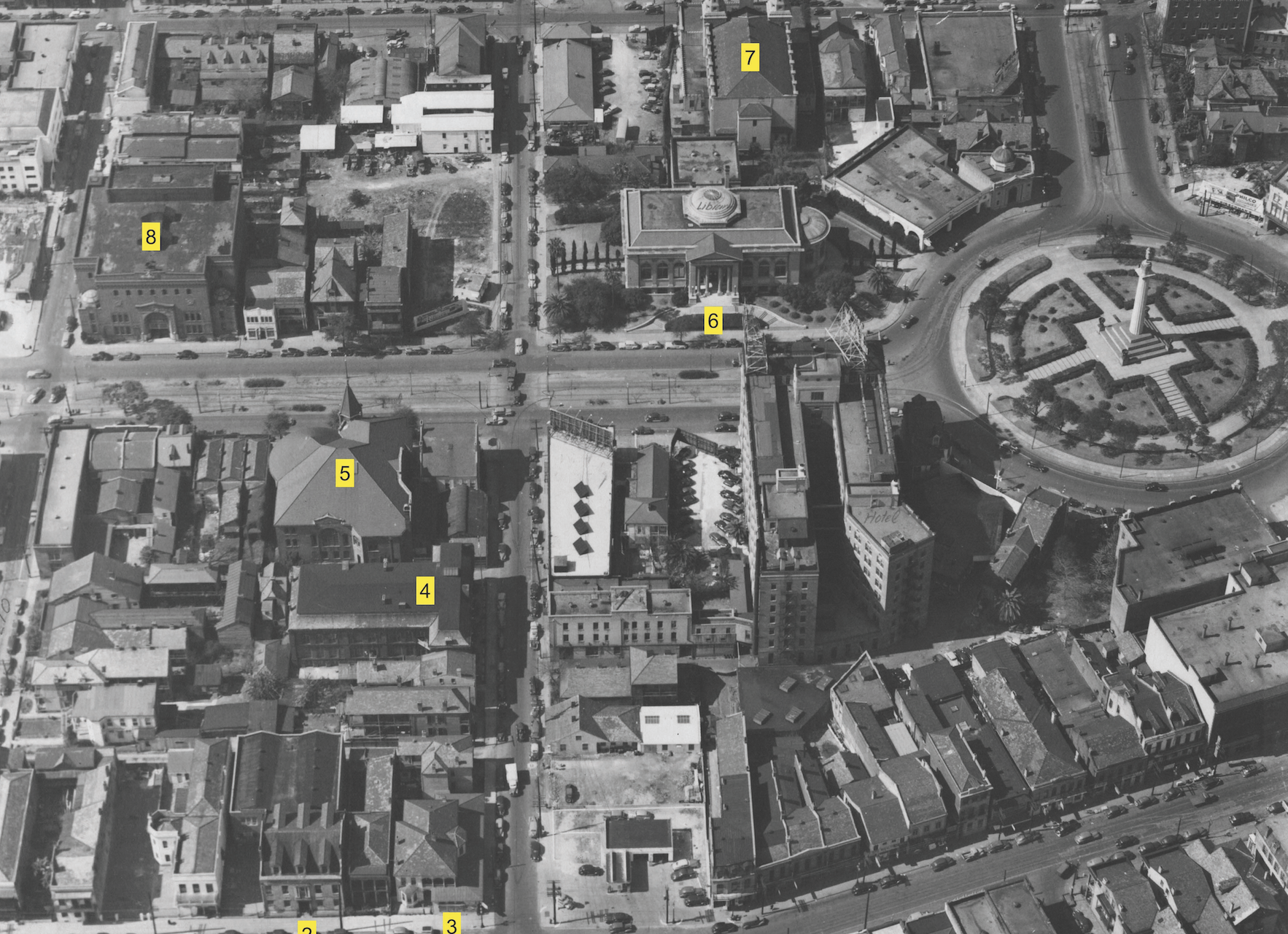This story appeared in PRC’s Preservation in Print magazine. Interested in getting more preservation stories like this delivered to your door? Become a member of the PRC for a subscription!
Are you familiar with the 50-year rule in historic preservation? It’s the nationally recognized guideline that a building, structure or place must be at least 50 years old to be considered “historic.” There are, of course, exceptions, but 50 years is a major milestone.
And by that standard, the Preservation Resource Center is now officially historic. We were founded in 1974 by passionate preservationists who dedicated the organization to supporting New Orleanians across the city in their fight to protect the places that residents love and value. The significance of our own landmark birthday is all the more special given our focus on this five-decade designation.
The PRC’s significance to New Orleans could not be more profound. As the late Edgar “Dookie” Chase, Jr., former PRC Board President, wrote in 2014, “The PRC has been a bedrock guide reminding us of why we should cherish our unique civilization, and of what we might lose of ourselves if we so easily surrender our core identity.”
Comments like that remind us how different New Orleans would be today if not for the hard work of the PRC’s many dedicated volunteers, board members, supporters and staff over the past 50 years.
During our half century of work, the PRC has continually evolved to meet the city’s changing needs, from protecting against disinvestment and blight to recognizing our cultural heritage sites and rebuilding after hurricanes and disasters, to grassroots activism and standing up programs focused on affordability in historic neighborhoods.
Preservation as a movement originally focused on preserving buildings that were sites of historic significance, but it has grown exponentially since then — and so has PRC’s work.
Preservation as a field and practice provides tools that are vitally important to some of the biggest issues that we face as a nation today. Preservation can also be a tool for healing, allowing us to acknowledge the past — even the most difficult stories of the past — and elevate the people, events and places whose histories need to be told.
In New Orleans, we enjoy living in a modern city that also has unparalleled historic authenticity. Our historic neighborhoods provide a high quality of life, and they are an integral part of our tourist economy. The PRC’s work has helped keep much of our city’s authenticity intact for 50 years. Indeed, without the PRC, New Orleans would be a much different city today. Our collective heritage is our city’s wealth, and we are blessed to still have so much of it.
Looking back, heading forward
The Preservation Resource Center was born from a groundswell of activism, collaboration and passion in May 1974. The civic trailblazers leading the Junior League of New Orleans at the time had been hearing from neighborhood leaders across the city who were increasingly irate about demolitions of historic buildings. Some demolitions were the work of the federal government, such as highway construction that destroyed the thriving Black commercial corridor of N. Claiborne Avenue and the historic residences bordering what is now the Warehouse District; some demolitions were done by developers speculatively tearing down architectural treasurers in the hopes of future payouts. All were done in the name of progress; most were damaging in ways that are still felt today.
The original charge of the PRC was to conduct research and inform residents on how to preserve housing and individual buildings. The PRC’s programs exploded in the years after its founding, but that early mission codified in PRC’s Articles of Incorporation was signed by 42 original Trustees on May 31, 1974. The Junior League of New Orleans seeded the PRC with three years of startup operating income, and empowered its new Board of Directors and the first PRC Executive Director Larry Schmidt to create an operation to serve New Orleans in a novel and important way.
By the end of the 1970s, the PRC had purchased and restored 604 Julia St. as its new office. This catalytic restoration of one of the famed “13 Sisters” of Julia Row helped spark interest and investment in the Lafayette Square neighborhood, turning Skid Row and its surrounds into a neighborhood revered for its vitality and beauty.
The first major program of the PRC addressed its charge to inform the residents of the city about housing and neighborhood news. Launched in 1975, Preservation Press was a quasi-monthly newspaper that would evolve into Preservation in Print magazine. Communications remains at the heart of what we do, and we have excelled over the past 50 years in helping the citizens of our great city understand why historic preservation is vital to New Orleans’ economic health and quality of life. Today, our communications efforts are multi-media, publishing our magazine, books, videos, a dynamic, interactive website, and, in recent years, a robust and effective social media presence.
Education has always been at the core of PRC’s mission. Our classes and workshops have shifted through the years as circumstances in the city have changed. After Hurricane Katrina, for example, PRC showed residents how to acquire and renovate blighted structures. In recent years, with energy efficiency and climate resiliency a major concern for many homeowners, PRC has educated residents on how to best maintain and make smart improvements to their homes. Our goal is always to meet a broad range of needs, which is why we have classes for people who are new to buying or maintaining a historic property, as well as specialized seminars for people versed in complex issues, such as historic rehabilitation tax credits and finance, or plaster and wood window repair.
The PRC has had a nationally lauded easement program for decades. Its early portfolio was bolstered when the Historic St. Marie Corporation merged with the PRC, bringing dozens of downtown easements with it. Today, the PRC protects 140 sites, mostly in New Orleans but some around the state. The properties range from hotels to private homes to office buildings. By ensuring their facades are protected in perpetuity, the PRC helps those pieces of the past shine on into the future.
Moving from educating the public into rebuilding structures was a big jump for the PRC, but it made the leap in 1988. The PRC’s Operation Comeback program began with support from major financiers and political players, including Mayor Sidney Barthelemy. The idea was to buy vacant and blighted properties in neighborhoods that needed investment, and then sell them to new residents, who were often first-time homebuyers. The profit from the sale of the house would fund the next construction project, often on the same block, or close by. At the same time, PRC launched Christmas in October — now called Rebuilding Together New Orleans — to provide free home repairs to low-income residents in the same neighborhood. Both programs enjoyed incredible success thanks to tireless work from their respective teams and were poised to make dramatic impact after Hurricane Katrina. In their 30 years of operation, those two programs rebuilt more than 1,000 houses.
Rebuilding Together New Orleans is its own separate nonprofit today, but its legacy lives on in the PRC’s Revival Grants program, which funds home repairs in historic districts for low-income homeowners.
Bolstering every initiative at the PRC is advocacy. Whether PRC representatives are at City Hall fighting an unnecessary demolition, or at the state capitol working to extend the Louisiana State Historic Tax Credit, the belief in wisely reusing our resources — our built heritage, our collective wealth — underlies all of PRC’s work.
Preservation means economic development for our city and state — and that leads to benefits for all. Preservation also means the safeguarding of our history and the celebration of our stories, be them triumphant or tragic.
When people think of preservation, many picture buildings. But the PRC has proven in the past 50 years that it’s so much more.
Progress through preservation
The PRC owes its success entirely to the passionate people who have propelled its work for the past half century. From workhorse board presidents to regular volunteers to major donors and members, thousands of people have supported the PRC in so many ways. For that, we are eternally grateful.
In planning our 50th Anniversary Gala — taking place May 17 at the Sazerac House, we hope to see you there! — we compiled lists of honorees to thank, and the process was staggering. The number is well over 1,000 people. And even then, I am sure we accidentally left people off the list. Thank you to all who have made our work possible — and continue to make us stronger and focused everyday on saving our historic treasures.
And thank you to the many staff people throughout the history of the organization who worked so hard to make these programs and initiatives a reality. Many former staff members have gone on to big roles in government, nonprofit and business leadership.
Finally, I am honored to be the fourth executive director of the PRC. Our first three — Larry Schmidt, Ann Masson, and Patty Gay — are true leaders, whose dedication to our city’s history and preservation has defined their life’s work. I look forward to raising a glass to all three at our gala later this month. Please come and celebrate with us!
Danielle Del Sol is the Executive Director of the Preservation Resource Center.
PRC’s achievements over the years
PRC was founded in 1974 by passionate advocates who wanted to protect New Orleans’ historic buildings and neighborhoods.
1970s
- Launch of Preservation Press newspaper, which later became Preservation in Print magazine. It has been in continuous publication since 1975.
- Creation of the Holiday Home Tour, an annual tradition in the Garden District since 1975.
- Support for the establishment of the Historic Districts Landmarks Commission, the New Orleans agency that controls rules and regulations in the city’s historic districts.
- Support for the establishment of historic districts around the city, including Irish Channel and Algiers Point in the National Register of Historic Places; and St. Charles Avenue (portion), Esplanade Ridge, Lafayette Square, Picayune Place, Warehouse District and Faubourg Marigny as local historic districts.
- Purchase and renovation of 604 Julia St., sparking a revitalization of the rest of Julia Row and the Lafayette Square neighborhood.
- Creation of the Julia Jump fundraising gala, held since 1977.
- Larry Schmidt serves as the PRC’s first executive director, followed by Ann Masson as the second executive director.
- Patricia H. Gay takes over as executive director in 1980. She will serve an incredible 37-year tenure marked by exponential growth and leadership.
1980s
- Launch of the PRC’s Façade Easement program. Today, we hold 140 easements across the state.
- Support for the nomination of Uptown, Esplanade Ridge, Central City, Carrollton and Holy Cross as historic districts in the National Register of Historic Places.
- Documentation of the Warehouse District, with support from the National Trust for Historic Preservation, to survey every building in the neighborhood. This work helped pave the way for the neighborhood’s transformation throughout the decade.
- Creation of the “Living in New Orleans” exhibit at the 1984 World’s Fair, which attracted half a million people to tour a reconstructed 1830s Creole cottage.
- Launch of Stained Glass in Sacred Places, a tour that would operate for 25 years showcasing the historic stained glass in churches, synagogues and temples along the Gulf Coast.
- Launch of Operation Comeback, a program to purchase and restore blighted properties in the Lower Garden District, beginning with 11 blighted buildings in the 1400 block of Magazine Street. The program had a 30-year tenure and restored vacant and boarded-up buildings in neighborhoods across the city.
- Launch of Christmas in October, a program — later renamed Rebuilding Together New Orleans — that used volunteer labor to renovate homes of elderly or disabled low-income homeowners. The program started by working in the same neighborhoods as Operation Comeback projects and later branched into neighborhoods citywide. The program had a 30-year tenure at PRC, and today, it is a separate, successful independent nonprofit.
1990s
- Launch of Live in a Landmark tours to attract prospective homebuyers into historic neighborhoods.
- Support and documentation for several districts added to the National Register of Historic Places, including Upper and Lower Central Business Districts, Bywater, Mid City, and Gentilly Terrace.
- Support for several new local districts, including Holy Cross, Algiers Point, Bywater, New Marigny, Parkview, and Tremé.
- Publication of Classic New Orleans, a book promoting the livability of New Orleans and its historic neighborhoods.
- Launch of the Shotgun House Tour to encourage appreciation of the local architectural vernacular type. This tour continues today as the Spring Home Tour.
- Launch of renovation workshops to teach homebuyers and homeowners how to repair historic buildings. These workshops continue today.
- Launch of the Great Neighborhood Sellabration, an event to attract homebuyers to historic districts. The annual fair would be held for 20 years.
- Establishment of the PRC African American Heritage Preservation Council. The committee, now called the Multicultural Heritage Committee, still influences PRC’s work today.
- Acquisition and renovation of the historic Leeds-Davis building at 923 Tchoupitoulas, which becomes PRC’s new headquarters in 2000.
- Establishment of the PRC jazz heritage program, which installed more than 60 historic markers on sites of jazz heritage and held an annual Ladies in Red gala to raise funding for the program.
2000s
- Launch of a children’s education program to teach students about New Orleans architecture and culture. The program educated more than 8,000 students.
- Launch of the Renovators’ Happy Hour series to showcase a historic site under renovation. Now called Beams & Brews, the tours are still popular today.
- Support for the inclusion of South Lakeview and Broadmoor as new districts in the National Register of Historic Places
- Support for the Irish Channel and the Garden District as new local historic districts.
- Acquisition of a warehouse to expand its capacity its rebuilding programs.
- Renovation of the former Central City home of pioneer jazz musician Edward “Kid” Ory in 2003 and the former Algiers Riverview home of noted jazz musician Henry “Red” Allen in 2004.
- Work with the state legislature to establish a State Homeowner Rehabilitation tax credit that lasted for about a decade.
- Immediate response to the catastrophic disaster of Hurricane Katrina. The PRC launched a series of programs to help residents rebuild. Thanks to a partnership with the National Trust for Historic Preservation and others, PRC was responsible for driving approximately $6 million in investment into rebuilding. For years, volunteers from around the country, including more than 150 AmeriCorps members, came to New Orleans to work with PRC to get families back home.
- Offered weekly workshops and classes to help homeowners recovering from Hurricane Katrina.
- Publication of two books by Preservation in Print editor Mary Fitzpatrick, Life in an Epic City in 2006 and New Orleans Favorite Shotguns in 2007, to promote the vitality of the city post-Katrina.
- Partnered with Cottage Living to build a modular “Idea Home” on Camp Street in Uptown.
- Opened an architectural salvage store on Marais Street to save historic building elements as rampant demolitions destroyed historic swaths of the city.
- Construction of a “Katrina Cottage” to bring historically appropriate new construction to empty lots in Holy Cross.
2010s
- Acquisition of 1423 N. Claiborne Avenue, the last remaining building of Straight University, one of the first historically Black colleges in New Orleans. The PRC restored the building and placed it individually in the National Register of Historic Places.
- Publication of Mary Fitzpatrick’s third book, New Orleans: Days and Nights in the Dreamy City.
- Co-hosting, with Tulane University, the symposium, “The Economics of Authenticity,” with attendees from 41 cities.
- Support for the nomination of Edgewood Park as a historic district in the National Register of Historic Places.
- Danielle Del Sol begins serving as the organization’s fourth executive director in 2018.
- Conduct the PRC’s first strategic planning process, which results in a new mission statement: The PRC preserves New Orleans’ historic architecture, neighborhoods and cultural identity through collaboration, empowerment, and service to our community.
- Launch of Revival Grants, a new program, supported in part by the National Trust for Historic Preservation, to provide free home repairs for low-income homeowners in historic districts.
- Publication of Building on the Past: Saving Historic New Orleans, a coffee-table book chronicling how people have saved historic buildings throughout the city.
- Launch of Mid Mod NOLA, an events series to enhance appreciation for Mid-Century Modern architecture.
2020s
- Growth of PRC’s robust social media channels, providing news and educational content for tens of thousands of people who love New Orleans architecture.
- Launch of innovative virtual programming during COVID lockdown to keep constituents informed and inspired, offering multiple classes or talks weekly for two years, keeping the organization strong through that unprecedented time.
- Support and assistance for the nomination of the Pontchartrain Park neighborhood in the National Register of Historic Places.
- Publication of The Cottage on Tchoupitoulas by Richard Campanella, published in conjunction with Children’s Hospital New Orleans.

